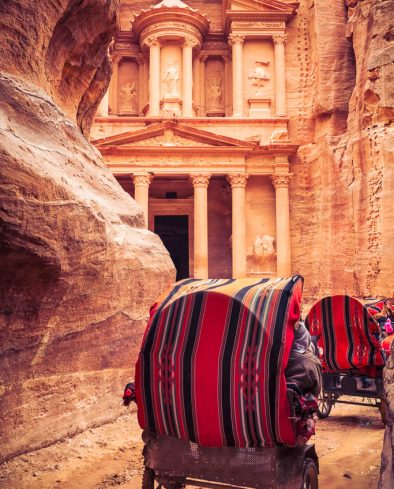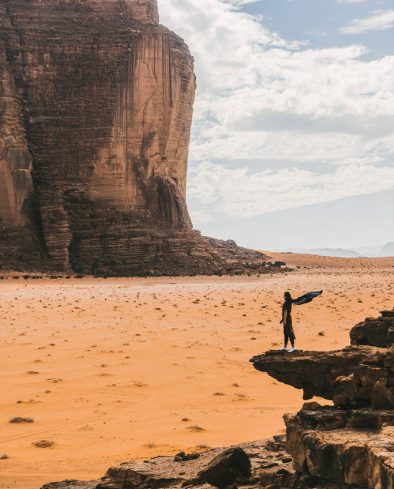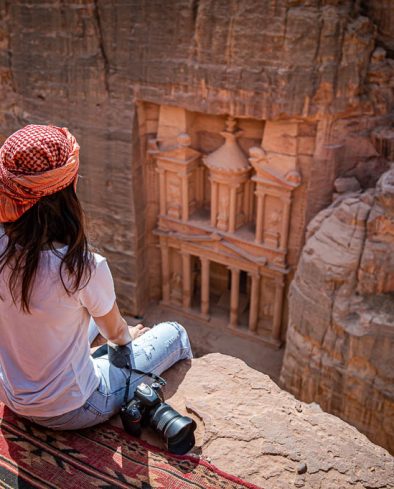Episode 21 - Petra
Explore the magical and mystical world of Petra, the ancient capital of the Nabataean Kingdom, as your host Stephen Bailey takes you to a new destination every single day.
Listen Now
I Was Never A Fan Of The World’s Seven Wonders
Today I want to take you on a magical and mysterious journey to one of the world’s seven wonders — Petra, in Jordan. One of the great ancient sites, where mausoleums are carved into sandstone cliffs and secret caves cover the landscape. Camels wander past. Donkeys too, sometimes carrying people. Across Petra, there are temples and monasteries that change colour, their sandstone moving from red to pink as the sun crosses the sky.
I was never a fan of the world’s seven wonders. You know, it’s really a marketing gimmick, the new seven wonders, and Petra is one of them. Usually it’s the one that people forget about when they have to think of what they’re going to be. And I don’t think I was a fan at all of the world’s seven wonders until I visited Petra.
And I stood inside this abandoned city, the former capital of the Nabataean kingdom. When I was in there, I really felt, okay, this is a world’s wonder. You’re not messing around here, this is not some of this marketing gimmick, you know, put some nice buildings together and call it a wonder.
Petra Is On Another Level
I mean, Petra is on another level. It’s really famous because it was in the film “Indiana Jones”. Well, specifically the burial chambers and the treasury were in “Indiana Jones”, and if you stay at any hotel near Petra, I can guarantee that they’ll have that film on loop every evening you are there.
The other famous Petra experience is the entrance. You can travel by horse-drawn carriage, or you can walk — with a horse-drawn carriage it is really worth it, it is fabulous — through this fissure, this narrow corridor, through the desert. It’s like you’re walking in this really narrow canyon. And this is why it’s most spectacular on horse and cart, you have no idea where you are going and you’ve just got to trust someone else.
And you’re going down this narrow canyon and it narrows and narrows, and then it opens. And there, in front of you, are the royal tombs, the burial chambers and the treasury. The city just expands, sandstone expanding in front of you.
The City Is Huge
That’s what you do on the first time you visit. And this is what really makes Petra special. This idea that you just don’t visit once, because you take the horse and cart, whether by day or at night, and you enter what is essentially the oldest and most concentrated area of ruins. A series of temples, it’s all carved into the sandstone, very spectacular.
You can spend a half a day just in that small area, around — you know, you can recreate Indiana Jones if you want, or just recreate something of the Nabataean kingdom, with a local guide who can explain what actually takes place there, or what did take place back in the day. Why these things are here, why it’s carved into the rock, what happened when the Romans ploughed through?
So you can do that. And it’s a fabulous experience, it’s absolutely amazing. And that is barely 2%, maybe 5%. It’s a tiny amount of the entire Petra site. And this for me is what made it such a spectacular place to be, and really made me feel “okay, this is a world wonder, it is not some kind of gimmick” — to see and get around all the places in Petra, you would need I think three days.
Visit at night, and it’s a completely different experience. At night what they do is, they light up the inside of it with these lanterns, very beautiful, very peaceful as well. Visit just for the experience, taking the horse and cart, the spectacular entrance, the famous sites around the entrance. And then you also need a full day to explore the rest of the city, because the rest of the city is huge, like it spreads over.
People Still Live In Those Caves
It was a great ancient capital. I mean, imagine 2000 years from now, when they look at the ruins of what today are our great capitals — you know, the ruins of London would spread for 50 miles, the same as any other great city. And that’s the same in Petra. You can walk down this street of columns, of marble, you can walk to the very outskirts of the city where temples are hidden — carved into the rock, but hidden kind of on a clifftop.
You can walk through the residential area of the city where people still live in caves. It’s remarkable. And those locals, descendants of the people who lived in Petra, will invite you inside, invite you to sit in what is a very cool — and I mean, temperature-wise, it’s very hot outside as you’re walking around — you go into their cave where they live and it’s wonderfully cool.
They’ve got carpets on the floor. They serve you mint tea, you have a chat, you discuss life. Perhaps haggle over a donkey, get a sense of what it’s like to live in — basically live inside a world wonder. It’s not actually that official because after it became a UNESCO World Heritage Site, people are not supposed to live there. But it’s still very much a part of life. And it’s such a huge city that people can live there unnoticed in caves.
In 2020, Petra Is Empty
What is great about Petra is its location. It’s in Jordan, in the Middle East, and a lot of people in the last 10 years — since the Arab Spring, 2011 — don’t want to visit the Middle East. Even though Jordan throughout this whole time has been completely peaceful, it’s the one country in the region that gets on with all of its neighbours. There’s never been a problem there, but it’s the Middle East, so some people are put off traveling.
And now with some of the coronavirus trouble, there’s not a lot of major travel from — especially coming from Asia, like big groups of people wanting to tick off the wonders of the world. And our travel designer in Jordan was saying, it’s so amazing at the moment, because it’s completely empty. You have this huge city pretty much to yourself and you can be alone walking through Petra, walking through those famous places, walking through a world’s seven wonder. Experiencing Petra, over two to three days, without any crowds, without any tour buses, without any groups of people following a red umbrella, without any of that carnage and chaos that distracts from the experience.
This travel designer said to me, “you know what? You can go in the horse and cart, and you’ll be the only person travelling through the corridor plan. The horse and cart can gallop through, because it doesn’t have to sidestep people walking into the city.”




